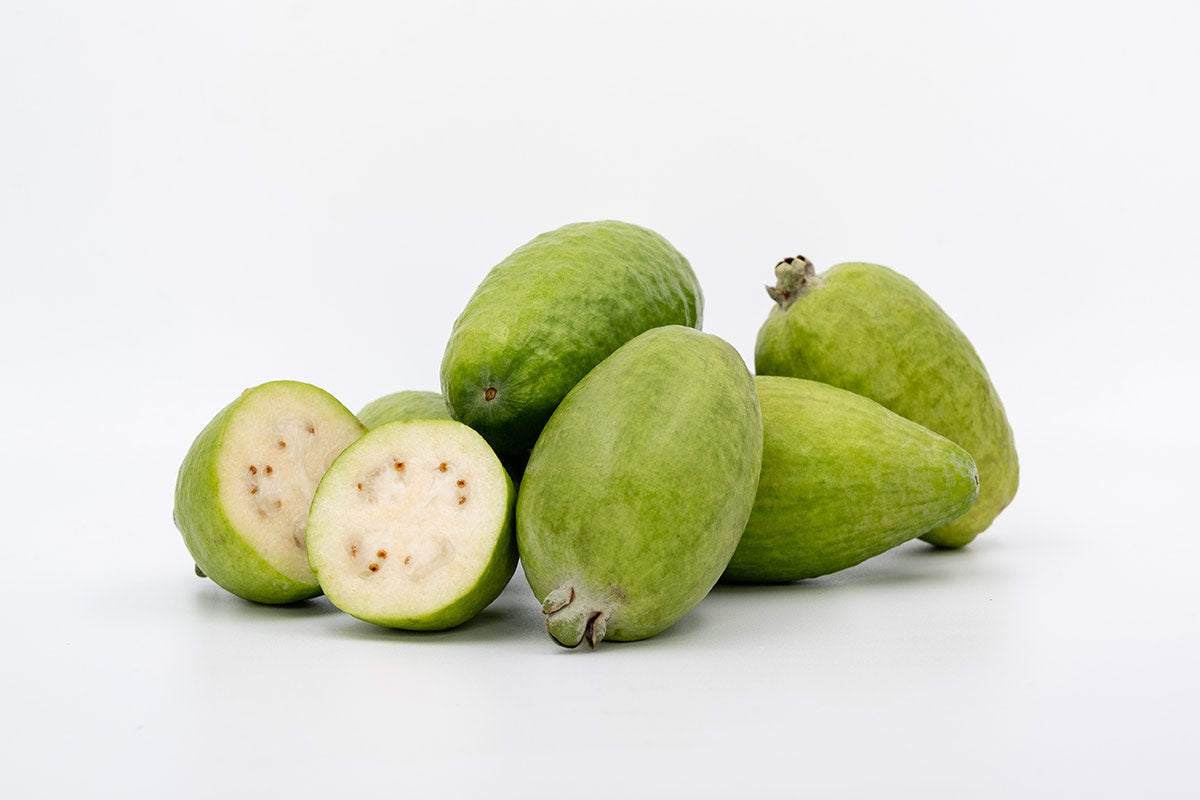About the feijoa
Feijoas are originally from South America (Brazil, Paraguay, Uruguay). The first record of samples travelling outside of
South America is in 1890, by a botanist named Edouard Andre.
Edouard brought these samples back to his country of origin, France. There cultivars were improved and distributed to other parts of the world. The feijoa plant was also grown for ornamental purposes in gardens.
Feijoas were brought to New Zealand in 1908 from Australia. Because few of their original pests followed them from South America, feijoas are easily grown organically and naturally in New Zealand. In fact Tauroa Farm, where our feijoas are grown, is a haven for birds and biodiversity. Feijoa flowers are pollinated by birds who feast on the sweet, pink petals.
The short growing season and lack of processing technology has traditionally limited feijoas to being enjoyed in the country where they're grown. But new processing and freezing techniques now make it possible to take feijoas further afield, with many more people able to enjoy their unique flavour and amazing nutritional benefits.
----

Nutritional benefits of feijoas
If you’re looking for a way to increase the nutritional impact of your diet, feijoas are an excellent solution.
Research continues to find that the feijoa has amazing bioactive properties. These properties are shown to have anti-microbial, antifungal, anti-cancer, anti-inflammatory, antioxidant and immunity stimulating benefits.*
Research continues to find that the feijoa has amazing bioactive properties. These properties are shown to have anti-microbial, antifungal, anti-cancer, anti-inflammatory, antioxidant and immunity stimulating benefits.*
The high concentration of beneficial compounds has caught the attention of the health industry with researchers now recognising the likely future benefit of owning patents in these potent products.

Good for the gut
Did you know that feijoas are almost as high in fibre as the avocado? Fibre has the benefit of not only keeping you regular, but also helping to fuel good bacteria in your gut.
----
The power of potassium
Feijoas sit somewhere between bananas and oranges in terms of potassium levels. Potassium is one of the electrolytes that regulate muscle function and help to keep the blood flowing.
----
Vitamin C
A 2017 Brazilian study demonstrates that feijoas are a good source of vitamin C. The flesh of feijoas has a higher concentration of the vitamin than in mangos and tangerines*.
The study goes on to inform us that 100 grams of feijoa is all that is needed for Brazilians to meet the national recommended daily Vitamin C requirement.
The research also confirms what many of us knew already – that vitamin C concentration is higher in the skin than the flesh. So eat that skin people! Lastly, the vitamin C concentration increased in both the skin and flesh after being stored. Go figure!
---
We pick the best feijoas
At Heather's Feijoas we only pick tree-ripened feijoas. The fruit takes about 120 days to develop. Around day 90 the fruit accumulates sugars and acids and rapidly grows in size.
Feijoas don't accumulate much starch (unlike kiwifruit and apples) that can be converted to sugar once picked. The fruit must be picked ripe for maximum sweetness and flavour, and the best nutritional value.
The flavour of feijoa is so unique it's hard to describe. If you had to compare it to other fruit, perhaps it's a combination of pineapple, guava, and strawberry, and very fragrant, with both sweet and tart aspects.
----
Feijoas are NOT Pineapple Guavas
Feijoas have been nicknamed pineapple guavas but there is another fruit in the guava family more aptly named pineapple guava. It is smaller, yellow and has larger seeds. Feijoas (feijoa sellowiana) and pineapple guavas are both in the myrtle family, the same family as the New Zealand Rata and Pohutakawa.

*Sources:
Feijoa Fruit, Mercedes C. Argüelles and Ronald Ross Watson
Chemical composition and antimicrobial properties of essential oil of Feijoa sellowiana O. Berg
Antibacterial and anti fungal properties of acetonic extract of Feijoa sellowiana fruits
Feijoas promise new anti-fungal treatments says Victoria research
New research shows humble feijoa has powerful anti-fungal properties
Plant Breeding In New Zealand
Fruit quality of Brazilian genotypes of feijoas at harvest and after storage
